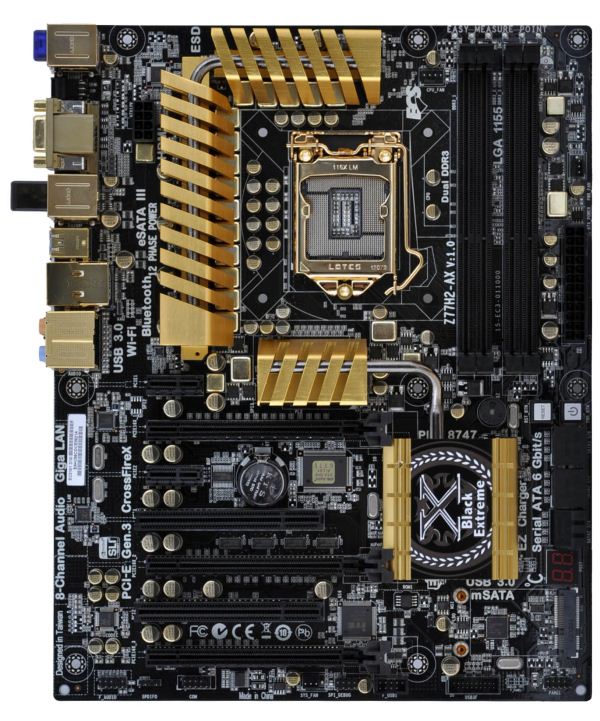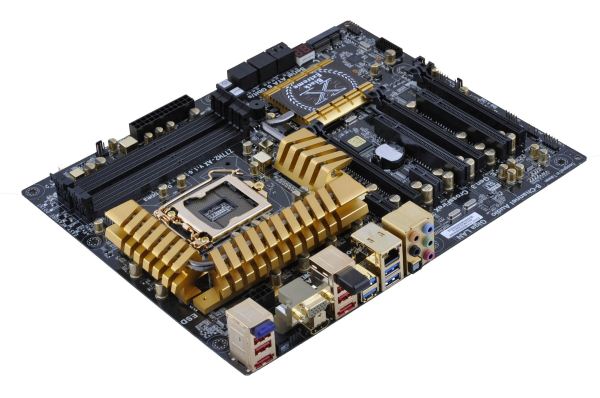Intel Z77 Panther Point Chipset and Motherboard Preview – ASRock, ASUS, Gigabyte, MSI, ECS and Biostar
by Ian Cutress on April 8, 2012 12:00 AM EST- Posted in
- Motherboards
- Intel
- Biostar
- MSI
- Gigabyte
- ASRock
- Asus
- Ivy Bridge
- ECS
- Z77
ECS Z77H2-AX—Visual Inspection
If all you ever wanted in life was something colored gold, I think ECS have you covered. As part of their Golden Board branding, the ECS Z77H2-AX has been plated with a layer of gold paint. Well, their heatsinks, heatpipes, socket, capacitors, VRMs and IO panel have all had a layer of gold paint added in order to improve aesthetics. When I first took this board out of the wrapper, I was figuratively blinded by just how much of the gold color was in my face.
Initially ECS will be releasing two high-end Z77 boards, with this one being the most expensive we have in for review, at an MSRP of $319. As such, I would expect it to perform near the top in almost every aspect—features, extras, performance and usability. As more than twice the price of the ASRock Z77 Extreme4, it had better be at least twice the board.
For a start, we can see that the socket is closed in, with the heatsinks and the memory slots being right up against Intel's minimum required socket spacing. This means big air coolers may not get a chance to fit, and only stock or water-cooling need apply. If that is the case, then I hope ECS have a robust overclock system in place.
One thing to feel disappointed by the ECS board though is the lack of fan headers. Around the socket you are lucky to have two—one 4-pin between the top VRM heatsink and the memory slots, and a 3-pin just above the 24-pin ATX power connector. A solitary third is on the bottom of the board. In the past ECS fan OS controls have had some of the better software support; however, it does not make sense to have only three headers on this.
Down the right hand side of the board, below the ATX power connector, are a pair of power/reset buttons, the standard six SATA ports from the PCH, and a two-digit debug display. Note we do not have any other SATA controllers for internal ports on the board. Below the two-digit debug display is an mSATA connector, which doubles up as a mini-PCIe if a user want to use a WiFi module (note, there is one on board already) or a TV Tuner.
On the south side of the board we are not given a vast amount of headers to say it is cramped—aside from standard front panel headers, there is a USB 3.0 header, a COM header, and a solitary USB 2.0 header.
This big selling point of this board over the other boards in this preview however is its multi-GPU capabilities. ECS have decided to invest in a PLX PXE 8747 chip, which is akin to the NF200 chips we saw on X58. This chip will expand the 16 PCIe 3.0 lanes on the board to 32, meaning that on the PCIe slots, we can have x16/x16 in dual card mode, or x16/x8/x8 in tri-card mode.
Thus in order we have an x1, an x16, x1, PCI, x16/x8, PCI, x8. So if all three full length PCIe slots are filled, there is still access to an x1 and a PCI, but we lose a lot of the functionality on the south part of the board.
The back panel has a mix and match of capabilities and functionality. From the left, we have a Bluetooth dongle, two USB 2.0 (red), an eSATA, a clear CMOS button, D-Sub, HDMI, a WiFi dongle, two USB 2.0, an eSATA, two USB 3.0, gigabit Ethernet, two USB 3.0, optical SPDIF and audio jacks. The big selling point for me is the WiFi, which ECS have cunningly added to their top range boards for a few chipsets now.
Board Features
| ECS Z77H2-AX | |
| Size | ATX |
| CPU Interface | LGA-1155 |
| Chipset | Intel Z77 |
| Power Delivery | 12 + 2 |
| Memory Slots |
Four DDR3 DIMM slots supporting up to 32 GB Up to Dual Channel, 1066-2800 MHz |
| Video Outputs | HDMI, D-Sub |
| Onboard LAN | Realtek 8111E |
| Onboard Audio | Realtek ALC892 |
| Expansion Slots |
2 x PCIe x16 Gen3 (x16, x8/8) 1 x PCIe x16 Gen2 (x4) 2 x PCIe x1 Gen2 2 x PCI |
| Onboard SATA/RAID |
2 x SATA 6 Gbps (PCH), Support for RAID 0, 1, 5, 10 4 x SATA 3 Gbps (PCH), Support for RAID 0, 1, 5, 10 2 x eSATA 3 Gbps |
| USB |
6 USB 3.0 ports (4 back panel, 2 from headers) 6 USB 2.0 ports (4 back panel, 2 from headers) |
| Onboard |
2 x SATA 6 Gbps 4 x SATA 3 Gbps 1 x USB 3.0 Header 1 x USB 2.0 Header 3 x Fan Headers 1 x COM Header 1 x SPDIF Output Header 1 x Front Panel Audio Header Power/Reset Buttons Debug LED 1 x mSATA |
| Power Connectors |
1 x 24-pin ATX connector 1 x 8-pin 12V connector |
| Fan Headers |
1 x CPU Fan Header (4-pin) 1 x SYS Fan Header (3-pin) 1 x PWR Fan Header (3-pin) |
| IO Panel |
4 x USB 3.0 Ports 4 x USB 2.0 Ports 1 x HDMI 1 x D-Sub 1 x Gigabit Ethernet 1 x Optical SPDIF Output 1 x Clear CMOS Button 1 x Wifi Connector 1 x Bluetooth 2 x eSATA 3 Gbps Audio Ports |
| Warranty Period | 3 Years from date of Purchase (3yr parts, 2yr labor) |
| Product Page | Link |
Despite having WiFi, mSATA and extended PCIe 3.0 lanes, the ECS board is down on audio (Realtek ALC892 rather than ALC898 of others), lacking fan headers and also lacking video outputs, with a lot of people requiring DVI to D-Sub or DVI to HDMI connectors.













145 Comments
View All Comments
MrSpadge - Sunday, April 8, 2012 - link
"multiples of 15 Hz (15, 30, 35, 60, 75)" on page 2Ryan Smith - Sunday, April 8, 2012 - link
Got it. Thanks.MrSpadge - Sunday, April 8, 2012 - link
How does it work together with nVidias adaptive VSync, which debuted with the GTX680? And which, IMO, looked quite promising (lowering average power consumption a lot while gaming).Ryan Smith - Sunday, April 8, 2012 - link
You wouldn't use MVP with Adaptive V-Sync. It only makes sense to use MVP by itself.Thaine - Thursday, August 16, 2012 - link
"Predicting which frames (or rendering tasks) will never be shown and taking them out of the pipeline so the GPU can work on what is needed"Along the lines of power consumption (and the ever-important side effect, heat), I would be very interested in seeing an article on MVP vs power consumption/heat on a power-hungry dGPU (ala GTX 480).
primonatron - Sunday, April 8, 2012 - link
Not sure why most of these boards bother including the non-Intel USB 3.0 controllers any more.Not many people have several USB 3.0 devices, so they could be saving costs. Or instead bringing back some of the things the article mention were taken away - like DVI on an ASUS board.
GreenEnergy - Sunday, April 8, 2012 - link
I think board makers are getting desperate for ways to add value.Less and less components to change and diversify with.
And its not getting better in the future. Haswell on LGA1150 basicly removes the entire VRM part on the motherboard. No more 32 phases or whatever.
A 50$ board performs identical to a 200$ board if you dont overclock. Actually the 50$ board might be more reliable (less components to fail) and more power efficient.
Xale - Sunday, April 8, 2012 - link
50 dollar boards are probably going to at least boot faster. The driver load and POST times with many 3rd party controllers, SATA especially, is atrocious. Seen some boards that take nearly 3x longer if the external controllers aren't disabled.Metaluna - Sunday, April 8, 2012 - link
Mostly marketing I would guess. Intel only supports 4 3.0 ports, so if you add another chip you now have a checklist item to justify the premium price of your motherboard and possibly differentiate it from lower-end versions in the same product line.Second, ASUS owns ASMedia, who makes a lot of the (mediocre, IMHO) USB 3 and Bluetooth controllers on their boards, so there's probably an incentive to use them in their own products to help prop up their production volumes.
Third, a lot of the third party controllers have special modes to support things like high-current charging for iPads or charging when the computer is turned off. Does anyone know if it's possible to add these features to Intel-based ports? If not, that would be an incentive to include a secondary chip.
GreenEnergy - Sunday, April 8, 2012 - link
I saw the DH77DF im looking at myself got high current recharge. So that doesnt seem to be related to the controller at all.